

Chance, Gesture and Surface with Louise Weaver. Inspired by her favourite abstract paintings in the NGV Collection, visual artist Louise Weaver shows how to interpret your experience of the natural world through experimental materials.
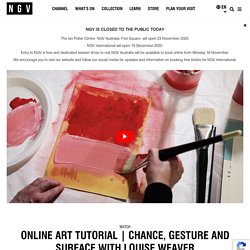
Weaver will demonstrate different ways of mark marking with paint using items found in your home and how to combine these with simple collage techniques to create exciting new compositions. Materials Paper, paint, paint brushes, kitchen paper, cardboard and scissors Facilitator Louise Weaver’s multidisciplinary practice employs a variety of media in the creation of both individual works and expansive sculptural installations that centre around the natural world. The paintings, sculptures and environments that Weaver creates interact with a broad range of themes. View work in NGV Collection.
How Does Mark Making Affect Your Paintings? As you explore painting, you might hear art professors, painting instructors, or book authors talk about 'mark making.' While it may seem like some complex, philosophical term used by artists, it is actually quite simple.
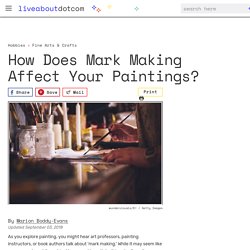
Every time your brush hits the canvas or your pencil makes a line, you are making a mark. It is a fundamental element in making any type of art and it is how we begin to express emotion, movement, and other concepts we wish to convey in an artwork. What Is Mark Making? Mark making is a term used to describe the different lines, patterns, and textures we create in a piece of art. Mark making can be loose and gestural, or structured and controlled such as hatching. It is easy to think of a mark as a building block for whatever you choose to create: A single mark creates a dot.An extended mark becomes a line.A cluster of marks become a shape.A series of repetitive marks become a pattern.
Should I Use Acrylic or Oil Paint? For a new or inexperienced painter, the decision about what kind of paint to use is an important one.
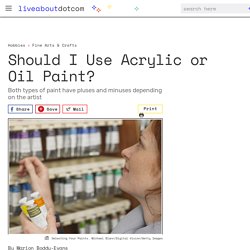
Most will be deciding between two types of paint: Oil or acrylic. Oil-based paints, which are made with linseed or other types of oils, have been used for hundreds of years by famous artists around the world. Oils offer vibrant colors and subtle blending. Acrylics, made up of synthetic polymers, are their newer cousins used by painters in the modern era. Practically speaking, the biggest difference between oil paints and acrylics is the drying time. Why Choose Oil Paints If you like to push the paint around and get it right, oils give you plenty of time. Oil paints have a distinct, strong odor that may be off-putting for some. More modern varieties of oil paints are water soluble, which makes it possible to clean them with water, and reduces their drying time. Why Choose Acrylic Paints Acrylics are made of pigment suspended in acrylic polymer emulsion. Oils Versus Acrylics.
Glossary of Art Terms and Definitions: Painting Mediums. The term medium has several different meanings in art.
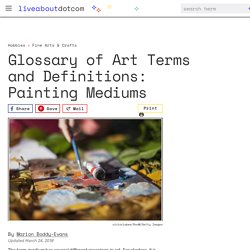
For starters, it is used to describe the substance that binds the pigment in paint. Wet-on-Wet Painting: Art Glossary Definition. Definition Wet-on-wet (also referred to as wet-in-wet) is one of those terms that quite literally means what it says.

Painting wet-on-wet is applying fresh (wet) paint onto a wet surface or onto paint that is still wet rather than onto paint that has dried. The result is colors that blend into one another and mix in the painting. Fine Art Painting Techniques Visual Index. Painting Technique: Pen and Watercolor A Visual Index of Painting Techniques If you've ever wondered "how did the artist do that?
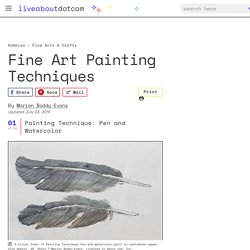
" and are looking for answers, then you're in the right place. These photos of various painting techniques will help you find out what was used to create various effects and styles of painting, and how to learn to do it yourself. These feathers were painted using watercolor over waterproof or permanent black ink.
WATERCOLOUR. DECALCOMANIA. GRATTAGE. The Best Art Paper for Painting Students: recommendations from an experienced teacher. Last updated February 8th, 2017 This article provides guidance for teachers who need to equip a classroom for high school Painting / Fine Art students – or for students who wish to purchase their own art supplies, ensuring that they are well-prepared for their high school Art course.

Papers and other materials are recommended by Amiria Robinson, an experienced teacher of Cambridge IGCSE and A Level Art & Design. If you are interested in seeing artwork that has been completed using the materials recommended here, please view this 100% AS Art Coursework Project, 99% IGCSE Art Coursework project, and 98% IGCSE Coursework project. Note: This collection of papers (and other drawing and painting surfaces) is designed to accompany a teaching programme that has an emphasis on acrylic and mixed media. It is not intended to be a ‘perfect’ list, but rather a sound base that can be tweaked and modified to suit individual teaching programmes as required! How to draw & paint faster: 15 tips for high school Art students.
Last updated February 8th, 2017 Are you struggling to get your Art projects done on time?
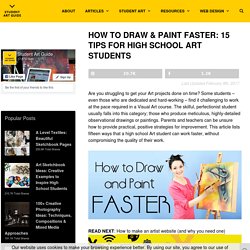
Some students – even those who are dedicated and hard-working – find it challenging to work at the pace required in a Visual Art course. The skilful, perfectionist student usually falls into this category; those who produce meticulous, highly-detailed observational drawings or paintings. Parents and teachers can be unsure how to provide practical, positive strategies for improvement. This article lists fifteen ways that a high school Art student can work faster, without compromising the quality of their work. Beyond the Brush: Inventive Use of Media for Painting Students. Last updated February 8th, 2017 This article outlines unusual painting and drawing techniques that are useful for creating exciting sketchbook pages, grounds, textural layers and adding tone and colour to an artwork.

While mastery of traditional painting techniques can be all that is needed in a high school art project, sometimes combining traditional methods with wild and inventive approaches is advantageous! Dip paper directly into paint / ink. How to make your Art Project exciting: creative mixed media. Last updated February 8th, 2017 Sometimes even highly able Painting students feel stuck in a rut.

If your IGCSE or A Level Art Coursework project feels stagnant, repetitive, or downright boring, you may benefit from increased experimentation with media, techniques and processes (the ideas listed below are also perfect for using in an A Level or GCSE Art sketchbook). While it is important to remember that art-making mediums should be used in a way that supports your ideas, there are times when a dash of unpredictability and thinking-outside-the-box can help. Paint on something interesting. Painting on Grounds: Inventive uses of media for Art students. One Point Perspective Drawing: The Ultimate Guide. Last updated January 12th, 2019 This article contains everything an Art student needs to know about drawing in one point perspective. It includes step-by-step tutorials, lesson plans, handouts, videos and free downloadable worksheets. The material is suitable for middle and high school students, as well as any other person who wishes to learn how to draw using single point perspective.
It is written for those with no prior experience with perspective, beginning with basic concepts, before working towards more complex three-dimensional forms. One point perspective: definition.